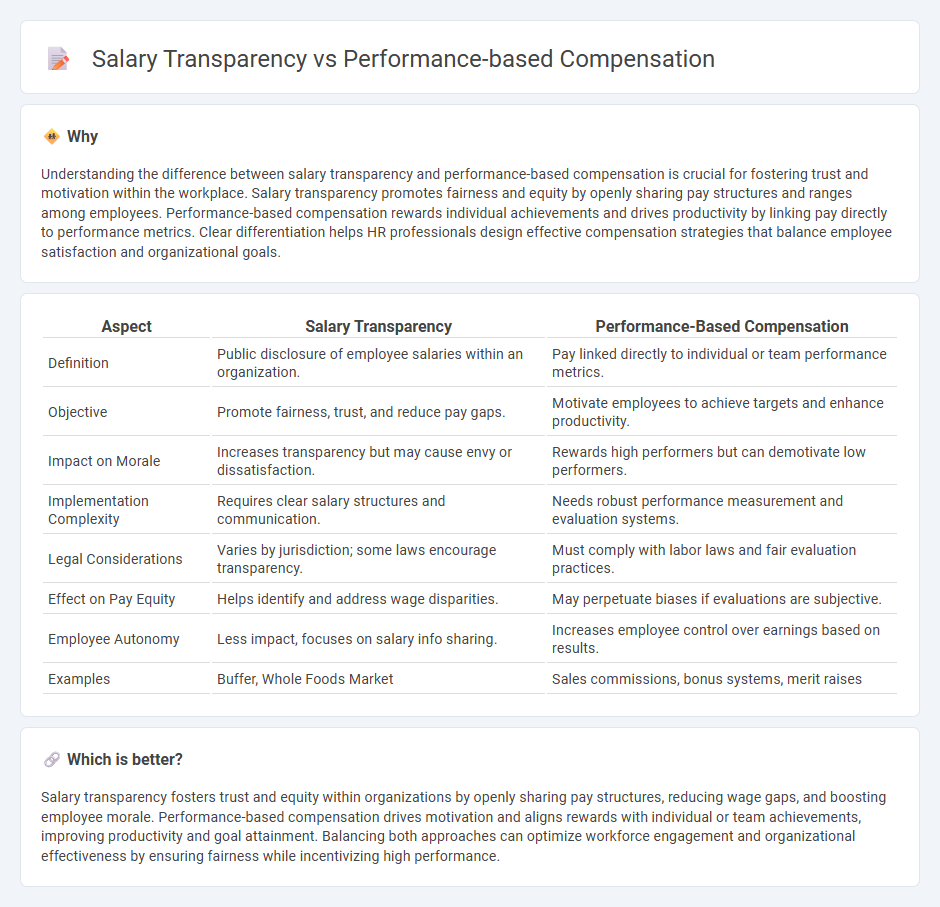
Salary transparency fosters trust and equity within organizations by openly sharing pay structures, which can reduce wage gaps and enhance employee morale. Performance-based compensation aligns rewards with individual achievements and productivity, driving motivation and accountability. Explore how balancing these approaches can optimize workforce engagement and retention strategies.
Why it is important
Understanding the difference between salary transparency and performance-based compensation is crucial for fostering trust and motivation within the workplace. Salary transparency promotes fairness and equity by openly sharing pay structures and ranges among employees. Performance-based compensation rewards individual achievements and drives productivity by linking pay directly to performance metrics. Clear differentiation helps HR professionals design effective compensation strategies that balance employee satisfaction and organizational goals.
Comparison Table
| Aspect | Salary Transparency | Performance-Based Compensation |
|---|---|---|
| Definition | Public disclosure of employee salaries within an organization. | Pay linked directly to individual or team performance metrics. |
| Objective | Promote fairness, trust, and reduce pay gaps. | Motivate employees to achieve targets and enhance productivity. |
| Impact on Morale | Increases transparency but may cause envy or dissatisfaction. | Rewards high performers but can demotivate low performers. |
| Implementation Complexity | Requires clear salary structures and communication. | Needs robust performance measurement and evaluation systems. |
| Legal Considerations | Varies by jurisdiction; some laws encourage transparency. | Must comply with labor laws and fair evaluation practices. |
| Effect on Pay Equity | Helps identify and address wage disparities. | May perpetuate biases if evaluations are subjective. |
| Employee Autonomy | Less impact, focuses on salary info sharing. | Increases employee control over earnings based on results. |
| Examples | Buffer, Whole Foods Market | Sales commissions, bonus systems, merit raises |
Which is better?
Salary transparency fosters trust and equity within organizations by openly sharing pay structures, reducing wage gaps, and boosting employee morale. Performance-based compensation drives motivation and aligns rewards with individual or team achievements, improving productivity and goal attainment. Balancing both approaches can optimize workforce engagement and organizational effectiveness by ensuring fairness while incentivizing high performance.
Connection
Salary transparency fosters trust and motivation by openly sharing compensation structures, which aligns employee expectations with organizational goals. Performance-based compensation directly links pay to individual or team outcomes, encouraging higher productivity and accountability. Combining these practices creates a transparent environment where employees understand how their efforts impact earnings, driving engagement and retention.
Key Terms
Pay-for-Performance
Performance-based compensation aligns employee rewards directly with measurable outcomes, enhancing motivation and productivity by tying pay to individual or team achievements. Salary transparency fosters trust and equity within organizations by openly sharing pay information, which can reduce wage gaps and improve employee satisfaction. Explore how combining pay-for-performance with transparent salary practices boosts organizational effectiveness and employee engagement.
Equity Compensation
Equity compensation aligns employee incentives with company performance, promoting long-term value creation through stock options or restricted shares. Salary transparency fosters organizational trust and mitigates pay disparities, encouraging fairness in total compensation packages. Explore how integrating equity compensation with transparent pay practices enhances employee motivation and retention.
Compensation Benchmarking
Performance-based compensation enhances employee motivation by linking pay directly to individual or team achievements, fostering a results-driven culture. Salary transparency promotes fairness and trust within organizations, enabling employees to better understand compensation structures and market positioning. Explore how compensation benchmarking integrates these approaches to optimize pay strategies and maintain competitive advantage.
Source and External Links
What is Performance-Based Compensation? Pros, Cons, Examples - This article explains performance-based compensation, including its definition, components, pros, and examples, providing insights into designing effective performance-based compensation programs.
Effective Strategies for Pay for Performance - This article explores pay-for-performance strategies, highlighting how they align employee incentives with organizational goals to enhance overall success.
What is Performance-Based Compensation? - This webpage defines performance-based compensation as a system that rewards employees based on performance, discussing its application and tax implications, particularly for public corporations.
 dowidth.com
dowidth.com